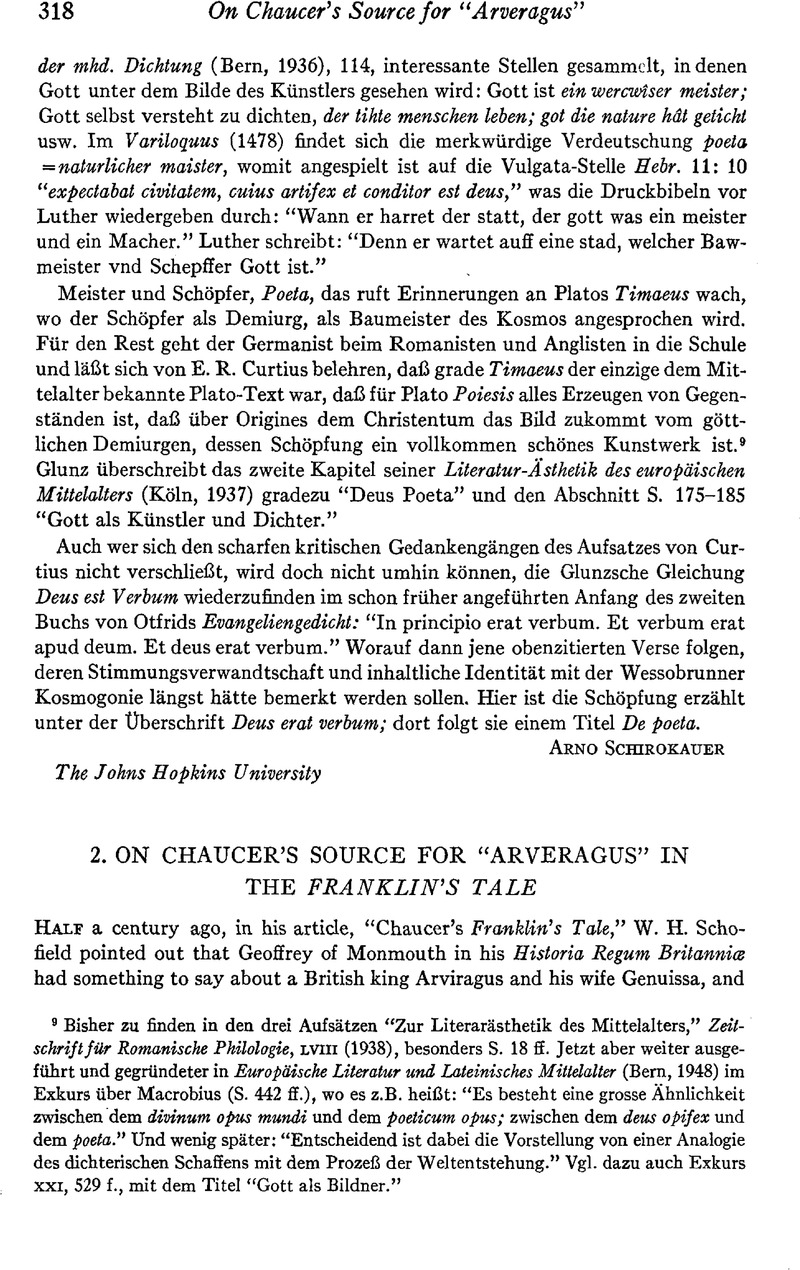No CrossRef data available.
Published online by Cambridge University Press: 02 December 2020

1 PMLA, xvi (1901), [405–449], 409–423.
2 Edd. W. F. Bryan and G. Dempster (Chicago, 1941), p. 383, q.v. for bibliography on this subject.
3 (Chaucer Society, 1914), pp. 62–74.
4 Ibid., p. 68.
5 Ibid.
6 Schofield, p. 437, regarded this as the great moral of the tale; F. N. Robinson, ed. The Complete Works of Geoffrey Chaucer (Boston, 1933), p. 831, says that it is the “first moral” and that the “second virtue … is gentilesse.”
7 Outside the Breton lay, in Geoffrey's Historia e.g., we find both British and Latin forms for names of British characters; and, in Layamon's Brut (in Madden's ed.), for Arvi-ragus we have the forms (in the earlier text) : Aruiragus, 9254,9367, 9433; Aruiragun, 9189; Aruiragune, 9187, 9499.
8 Pio Rajna, himself an opponent of Schofield's lay theory, pointed out (“Le origini della novella narrata dal ‘Frankeleyn’…, ” Romania, xxxii [1903], 207) that Geoffrey's “tantarum … nuptiarum” (Bistoria, bk. IV, ch. 15) did not justify the translation (of Giles, which Schofield used), “of so great and happy a marrriage”, and that Geoffrey makes no mention of any affection of the wife for her husband Arviragus.
9 Op. cit., p. 437.
10 Frederick Madden ed. (London, 1847), i, 418–420, in the earlier version; the later version has essentially the same matter.
11 iii, 340. See Wace's Brut, 5133–54, ed. Ivor Arnold (Paris [SATF], 1938), vol. I (525477 in the Le Roux de Lincy ed., Rouen, 1836–38, vol. i, which Madden used).
12 See above, note 8.
13 See also 9856 ff. in Layamon.
14 For Arviragus' promise, see, besides the passage summarized here, 9498–9535 in Layamon; cp. Geoffrey's Bistoria, bk. iv, ch. 14.
15 Op. cit., p. 413, n. 1 : “In the life of Arviragus the English historian [Layamon], as usual, greatly expands Wace, his original…, but here without adding anything really significant.”
16 The possibility that Layamon concocted this material seems unlikely, for Chaucer's association of Arveragus and his wife with a plea for the keeping of one's pledge seems to have not a coincidental but an analogous relationship to Layamon's matter, pointing to some common source or tradition. If he did not concoct it, this material is further evidence that Layamon added a good deal from his own reading or knowledge to what he found in Wace, and in Wace's source, Geoffrey. Although some have regarded Layamon's additions as largely creations of his own, the latest editor of any considerable portion of the Brut, Joseph Hall (Selections [Oxford, 1924], p. vi), thought it “highly probable that… Layamon … had gathered much legendary lore in his wanderings and had wrought it into the texture of his poem.” Cp. substantially the same view of Madden (i, xvi), and his further view (and of course that of others), which the evidence of this paper tends to support, that Geoffrey “was not a mere inventor.”
17 Cp. what J. Burke Severs—“Chaucer's Originality in the ‘Nun's Priest's Tale’”, SP, XLiii (1946), 28–29—shows may have happened in Chaucer's handling of his source material in the NPT.
18 FrklT, 1292–93 (Robinson ed.). Italics mine.
19 That he knew the Historia well is at least as likely as F. Lot's view (in a review of Schofield's article, in Moyen Age, vi, 2nd ser. [1902], 111) that Chaucer's knowledge of it was so superficial that he had a confused recollection of Arviragus. On the availability of the Historia, cf. Acton Griscom—ed. Historia (London, 1929), pp. 6–19—who observes that there are at least 190 MSS surviving from the 12th to the 15th centuries.
20 The Aurelius story in Wace (8037 ff. in Arnold's ed.) and in Layamon (17174 ff.) is essentially the same as that in Geoffrey.
21 Besides the tale, see Tatlock, The Scene …, p. 20: “Chaucer took much pains to put the story back in Roman times. …”